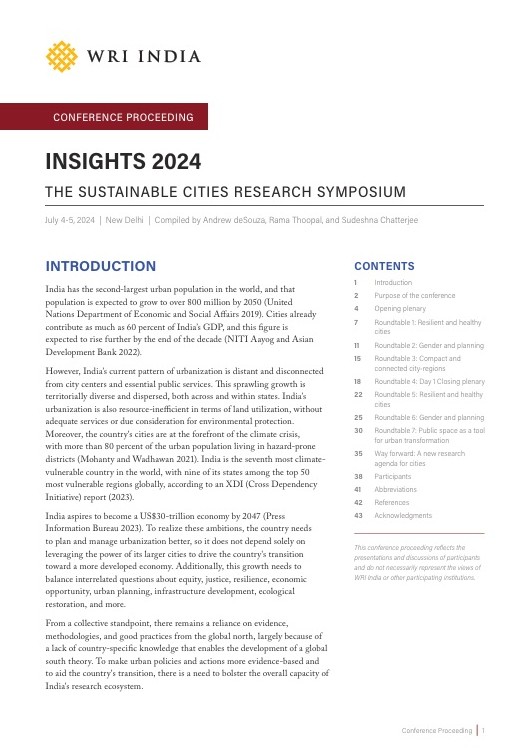Why India Needs to Adopt the Vision Zero Approach to Road Safety
by -
India has the highest number of road accident deaths in the world. In 2014, the National Crime and Records Bureau recorded 142,000 deaths, a sharp rise from 98,000 deaths in 2005. This increase has fast outpaced the corresponding population growth during the same time period. A majority of road accident victims are in the age group of 15 to 45 years, which not only puts a serious economic burden on their families, but also has a significant impact on the GDP of the country. This problem will grow to more alarming proportions, unless we make take urgent and far-reaching measures to overcome the situation.
Over the years, the national, state and city level governments, have made a number of attempts to address this problem. However, they have had limited success, partly because their initiatives are not unified under a comprehensive and coordinated strategy. Moreover, the scale of these initiatives is too limited to make a significant impact. India can stand to learn from some of the successful road safety strategies adopted by other countries. Once such popular approach is called Vision Zero.
Vision Zero is a comprehensive road safety strategy, pioneered in Sweden in 1997. Under this strategy, Sweden has made many far-reaching and path-breaking decisions, on the path to zero road fatalities, including reassessing their priorities in transport planning and road design. Vision Zero is based on 4 guiding principles:
SAFETY COMES FIRST
The Vision Zero approach pegs human life and health above all other transportation challenges. It states that when solving for issues like traffic flow, congestion or road capacity, safety for all road users must be never be compromised. This seemingly obvious principle is often neglected in the way we design our transport systems. For instance, vehicles in India, which do not meet even basic safety standards, are allowed to be sold in order to keep costs low. Furthermore, roads are designed to move the maximum number of vehicles as quickly as possible, without much thought given to the safety of vulnerable road users, such as pedestrians and cyclists. By adopting this principle of Vision Zero, transport authorities are forced to redefine their priorities, which changes the way one thinks about and plans for transport systems.
ACCOUNT FOR HUMAN ERROR
Vision Zero accepts the inherent fallibility of human-beings, and accepts that to some extent, human error in unavoidable. It states that transportation systems, including roads and vehicles, need to be designed taking into account that people might make mistakes, so that when crashes occur owing to human error, it does not result in fatalities or serious injuries. Accepting human fallibility is a necessary benchmark for almost every industry, where products and services are mandated to be designed to be “bug-proof”, that is, to take into account some extent of unintentional misuse. However, transportation systems are not held accountable in the same way. Vision Zero sets the following guiding principle which says that roads should be designed based on how people will behave, not on how they should. Thus, it advocates self-explanatory infrastructure that encourages or induces safe road behaviour by making it instinctive, with less reliance on traffic signage.
WE’RE IN IT TOGETHER
Vision Zero accepts that there is a joint responsibility for safety between the road user and road authorities. Conventional thinking is to attribute the cause of most road accidents to a single factor, and more often than not, to driver or pedestrian behaviour. For instance, 94 percent of road accident deaths in India in 2014 were reported as caused due to human factors, such as over-speeding, reckless driving, and drunk driving. Only a negligible fraction of accidents were attributed to defects in road infrastructure. The Vision Zero approach accepts the multi-factor nature of road accidents, and recognises that it is incorrect to attribute cause to a single factor. It advocates a scientific assessment of an accident in order to understand how various factors interplay to cause an accident. Vision Zero recognises the important role that safe road infrastructure can play in reducing both the risk and severity of accidents.
CO-ORDINATED STRATEGY
Vision Zero is based on a comprehensive and consolidated strategy to road safety that involves all authorities and agencies responsible for road transport systems. Vision Zero recognises that departments working in silos will have limited impact, as road safety is a multi-disciplinary problem. This approach requires a unified strategic vision to be set that lays out the mechanisms for coordination between all stakeholders. Coordinated initiatives have a higher probability of achieving the goal. This coordination is essential both at the inter-departmental level, as well as the inter-government level, since transport and road safety issues span the jurisdictions of all 3 levels of government.
Since adopting the Vision Zero approach, Sweden has reduced its road fatalities by more than 42 percent. Several countries and cities have since adopted the *Vision Zero *approach, such as Canada, Norway, New York, and others.
WRI Sustainable Cities aims to bring momentum to the Vision Zero approach in India. To this end, we’re convening India Vision Zero, a road safety forum to deliberate on challenges, opportunities, and solutions towards reducing road traffic fatalities in India. The objective is to bring together representatives from the Centre, States, cities and other stakeholders, such as civil society, media and sector experts, in order to facilitate dialogue on shared concerns, ideas and strategies for road safety reform in the country. India Vision Zero aims to create a coalition of informed stakeholders, committed on working towards the goal of zero road fatalities in the country.
The first of these forums will be held from 18-20 September 2016 in Bhubaneshwar, Odisha, around the theme 'Safer Roads for Safer Cities'.


